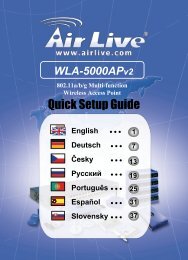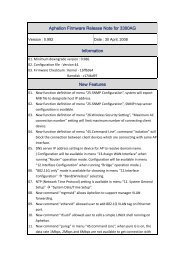Dual-Band Outdoor Access Point / Bridge User Guide
Dual-Band Outdoor Access Point / Bridge User Guide
Dual-Band Outdoor Access Point / Bridge User Guide
You also want an ePaper? Increase the reach of your titles
YUMPU automatically turns print PDFs into web optimized ePapers that Google loves.
Radio Path Planning<br />
3<br />
direction. The antenna polarization is marked on the wireless bridge, as indicated in<br />
the following figure.<br />
V<br />
H<br />
Radio Interference<br />
The avoidance of radio interference is an important part of wireless link planning.<br />
Interference is caused by other radio transmissions using the same or an adjacent<br />
channel frequency. You should first scan your proposed site using a spectrum<br />
analyzer to determine if there are any strong radio signals using the 802.11a<br />
channel frequencies. Always use a channel frequency that is furthest away from<br />
another signal.<br />
If radio interference is still a problem with your wireless bridge link, changing the<br />
antenna polarization direction may improve the situation.<br />
Weather Conditions<br />
When planning wireless bridge links, you must take into account any extreme<br />
weather conditions that are known to affect your location. Consider these factors:<br />
• Temperature — The wireless bridge is tested for normal operation in temperatures<br />
from -33°C to 55°C. Operating in temperatures outside of this range may cause the<br />
unit to fail.<br />
• Wind Velocity — The wireless bridge can operate in winds up to 90 MPH and<br />
survive higher wind speeds up to 125 MPH. You must consider the known<br />
maximum wind velocity and direction at the site and be sure that any supporting<br />
structure, such as a pole, mast, or tower, is built to withstand this force.<br />
• Lightning — The wireless bridge includes its own built-in lightning protection.<br />
However, you should make sure that the unit, any supporting structure, and cables<br />
are all properly grounded. Additional protection using lightning rods, lightning<br />
arrestors, or surge suppressors may also be employed.<br />
• Rain — The wireless bridge is weatherproofed against rain. Also, prolonged heavy<br />
rain has no significant effect on the radio signal. However, it is recommended to<br />
apply weatherproof sealing tape around the Ethernet port and antenna connectors<br />
for extra protection. If moisture enters a connector, it may cause a degradation in<br />
performance or even a complete failure of the link.<br />
3-5




